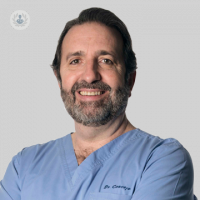Advances in Maxillofacial Surgery
Written by:Dental implants
Oral invalidity is a very frequent problem among people over 65 in Spain. It is estimated that one in five people belonging to this age group is totally edentulous. For these cases, the surgery of the dental implants has achieved spectacular advances, being possible nowadays to replace the false teeth by fixed teeth in only one day.
One of the latest technological advances in this field is the minimally invasive guided implantology, a technique that allows - from sophisticated computer programs with 3D technology - to place the implants practically without surgery and in a very precise way, which also gives good results it diminishes of very remarkable form the inflammation and the pain.
The most complicated cases are still those in which there is no bone where to anchor the implants. Although it is possible to choose to place bone grafts nowadays, it is possible to avoid it thanks to a new technique based on placement of the implant in the bone that exists below the cheekbones are the so-called "zygomatic implants".. This would allow us to place fixed teeth even in cases where the bone has been almost completely lost.
Orthognathic surgery
Orthognathic surgery consists of operating the bones of the face to achieve an improvement in appearance and smile. Usually, these interventions are performed in patients who have a bad occlusion, ie a misalignment of the teeth but, apart from getting a perfect smile, the benefits on the face are very important as it seeks to regain harmony between different areas of face
To obtain the best results, pre-surgery analyzes are carried out using photographs and 3D images of the patient, obtained with modern low-radiation scanners.. These tests are entered into the computer, where they are analyzed through specific programs based on 3D technology, which allow us to determine precisely how the bones are placed and how they affect the different parts of the face.
The same program allows us to modify the position of the bones of the face to establish the normal values. In this way, we managed to make an approximation of how the new face will look after the operation.

Benefits of new technologies
This technology applied to surgery has managed to reduce the duration of operations, simplify procedures and shorten the hospital stay, making this type of operations increasingly common interventions.
How orthognathic surgery is performed
A standard operation is performed under general anesthesia, lasts between 2 and 4 hours and requires a hospital stay of about 24-48 hours. The greatest benefit for the patient is that the postoperative period occurs with hardly any pain and with a variable inflammation that disappears in a period of between 7 and 10 days.
The patient will not have visible scars - they are all inside the mouth - and can start eating a soft diet after 2 weeks. In the case of our clinic, we have the added advantage of having a plastic and aesthetic surgeon, which allows us to combine these procedures with others such as aesthetic rhinoplasty, cervical liposuction or prosthesis of cheekbones.
Treatment for Sleep Apnea
Sleep apnea is a serious problem and severe cases have a mortality four times higher than people without apnea. The solution is to sleep connected to a machine called CPAP that introduces pressure in the airway, but there are people who can not tolerate it well and others who simply do not want to sleep all their lives plugged into a machine.
In these cases, orthognathic surgery is an effective technique to solve almost all situations. The most serious cases are solved by moving the bones of the face forward to expand the airway, taking advantage of the 3D planning that calculates how much we can move these bones without harming the physical appearance.


